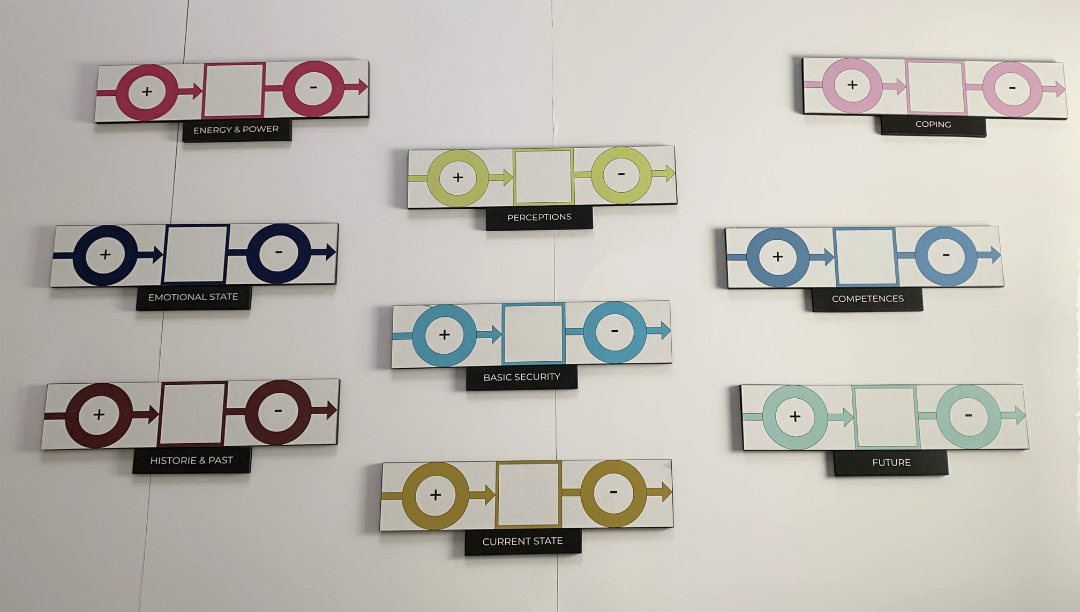SIM-GAMES
UNLOCKING THE LAYERS OF 5 KEY ISSUES
What makes an issue complex?
Coherence!
The special ways in which factors and actors are connected.
What unexpected combinations they make.
How they interact over time.
If you want to act and decide successfully in a complex situation, it is necessary to visualize this coherence.
A great way to unbundle and see the connections is the simulation game.
A sim game requires a time investment of 1 day.
In the sim-game you work in a physical learning landscape in real time to unravel a complex issue around one of the 5 key issues. Central topics that play a key role in almost every situation.
This can be an issue you raise yourself or a case that we provide and that is studied in advance.
Together with colleagues, you visualize the different layers and connections with which the issue is constructed.
In this constructed landscape you then test which decisions and interventions can have which consequences over time.
LAYERS of TRUST
LAYERS of RESILIENCE
LAYERS of RISC
LAYERS of DEVELOPMENT
LAYERS of RESULT
Investigating a complex issue can be vulnerable. The sim games are therefore performed under direction. We work in a dialogue format, which excludes polarizing discussions. We guarantee a constructive learning climate, in which everyone feels free to express themselves and think along to the fullest extent!
We developed the following sim games around the 5 key issues.

sim-game 1
LAYERS OF TRUST
Trust is a key concept.
It is fragile, it disappears quickly and is difficult to regain.
It gives a lot of energy, it makes and breaks initiatives.
It is used and abused and causes enormous damage in its absence.
Trust is seen as our ability to dare to depend on something or someone that you are not sure is justified. It is related to experiencing and assessing risks. And experiencing risks is connected to our sense of (basic) safety.
To build trust we need information. Information we gather from a wide range of sources and locations over time. Information that we receive in our brains in quite a variety of ways and interpret and understand in our own unique way.
The more we can visualize this complex relationship, the more we understand the comings and goings of trust in a situation.
In this sim-game LAYERS OF TRUST we visualize the complex of connections and aspects that together determine the level of trust in a situation.

sim-game 2
LAYERS OF RESILIENCE
Resilience is a key concept.
It is one of the most special properties of living nature.
It is the adaptive capacity to continually achieve a new balance.
A new stable state in which one can survive.
We know resilience as an individual’s ability to overcome setbacks, break new ground or recover from limitations. But also as the flexible force of organizations, projects and initiatives to respond to undesirable situations.
When circumstances or events require it, a complex system is set in motion. A combination of processes starts that work closely together to ensure that the original equilibrium is moved to a new stable equilibrium.
The manifestation of resilience is a process in which multiple factors interact and depend on each other.
LAYERS OF RESILIENCE brings a deeper insight into the ways in which resilience is created, increased or decreased in a situation. This insight immediately offers opportunities to improve the quality of decisions, interventions and strategies.

sim-game 3
LAYERS OF RISK
Risks, we know them, we fear or expect them, we deny and fight them.
Risk is a permanent player in our daily reality. Often indicating a real danger, but often also arising from fear and uncertainty.
With all its consequences.
Risk expresses a chance, a possibility or threat that something undesirable could happen. We continuously assess these opportunities, helped by our evolution, knowledge, experience, intuition and many tools. But also through perceptions, images and beliefs that influence our efforts.
It is a complex of factors that compose our images of impending danger. Cause and effect are sometimes illogically far apart. What seemed completely safe and controlled suddenly turns out to harbor great danger.
LAYERS OF RISK brings a deeper understanding of the ways in which risks in a situation are created, increase or decrease. This insight immediately offers opportunities for setting up ’tipping points’ over time and improving the quality of decisions, interventions and strategies.

sim-game 4
LAYERS OF RESULT
Result is a key concept.
That which has been achieved, the consequence, the outcome.
Result describes something that becomes visible at the end of a process of effort.
It is a moment in time, where the same time can make the quality of the result relative again.
We do our best to benefit from results for as long as possible. We use it to make a good impression, we lose sleep over it or we save lives with it.
The quality, impact and sustainability of a result depend on a complex of factors and circumstances. Factors that we did not initially see, despite all the monitoring, that suddenly presented themselves or that we thought we had successfully resolved.
LAYERS OF RESULT brings a deeper insight into the effectiveness of the path that leads to the result. Hidden aspects and their mutual relationships are also revealed that ensure that a result has the desired quality and sustainability.
This insight immediately offers opportunities to improve the quality of decisions, interventions and strategies.

sim-game 5
LAYERS OF DEVELOPMENT
Development is a key concept.
It is a process of change. Change through growth, a response to new circumstances or the blossoming of talent. But also realizing something new from ideas, experiences and research.
It is the dynamic path from purpose, through action and adaptation, to new.
There is always development, if only because time passes and things continuously change during that time. In ourselves, in our efforts, in our society, in our organizations and in the nature of which we are a part.
Sometimes we are the object of a development, often we are part of it and are responsible for it. Development processes are complex. Several factors together determine the pace, the side effects, the impact, the result, etc.
The extent to which we can steer a development in the desired direction depends on insight into the dynamics and coherence of the factors that play a direct and indirect role in the development process.
LAYERS OF DEVELOPMENT brings this deeper insight. A clear, sometimes new, picture of how the various factors in the development process influence and depend on each other.
Testing management options provides direct insight into possible effects and consequences over time.
LET’S PLAY !
Based on the principles of System Dynamics, we developed a visual language and attributes with which a complex situation can be visualized in an accessible way.
Central to the learning landscape is the Central Column.
It is the place where the total ‘stock’ of the chosen key issue is built up.
As an example, the key issue TRUST with the Current Stock.
A ring has been placed around the column that represents the fluctuating total score.
On this ring we see several topics that are directly related to the key issue TRUST.
When the stock of TRUST increases or decreases, immediately topics such as Learning Ability, Thinking Ability, Creative Ability, decrease or increase.
9 BASIC AREAS
The ‘stock’ of the chosen key issue is determined by several areas.
We have choose 9 basic areas. Each area represents an essential part of our daily lives that can influence the key issue.
From current influences to influences from the past, future, from information, energy and condition, to influences from emotional state and security of existence.
The participants choose 1 to 3 areas based on the case.
RELEVANT ASPECTS
Within each basic area a choice can be made for aspects that play a role in that area.
We continue with the example of TRUST.
In the PERCEPTIONS area you can choose aspects such as assumptions and expectations, but also public opinion or beliefs.
Each relevant aspect receives a score and when added together they have a positive or negative influence on the total ‘stock’ of TRUST.
RELATIONSHIPS
The 9 basis areas have a direct influence on the key issue, but can also influence each other.
Various relationships are conceivable and we make these relationships physically visible.
For example, it may happen that the score for an area is quite negative, but still has a much less negative impact on trust due to the relationship with another area. Or vice versa.
THE RESULTS
The playing field shows which aspects have a direct, coherent or more hidden influence.
This opens up the opportunity to play: testing the effect of interventions, strategies and decisions. The constructed system provides feedback regarding feasibility, desirability, ethics, costs, efficiency, etc.









